Schneider
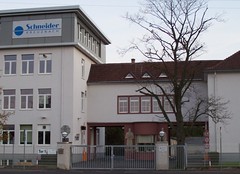
|
| Schneider Kreuznach in Bad Kreuznach, Germany image by Uwe Kulick (Image rights) |
Schneider or Schneider Kreuznach is the popular abbreviated name of a manufacturer of industrial and photographic optics. Besides Carl Zeiss Jena and Meyer-Optik-Görlitz it was one of the leading German lens makers during the 20th century and is existing as a company to the present day. It was founded in 1913 as Optische Anstalt Jos. Schneider & Co., changed its name in 1922 to Jos. Schneider & Co., Optische Werke, Kreuznach, and in 1998 to the current Jos. Schneider Optische Werke GmbH.
History
Josef Schneider (*26.02.1855, +20.10.1933) was the child of a brewer and innkeeper in Kreuznach, Germany. After completing a commercial apprenticeship and marrying a wine merchant's daughter in 1866, they both moved to Springfield, Ohio (USA) in 1877, where they took American citizenship and built a brewery under the name "Schneider Brothers". In 1888 their son ‘’’Josef August Schneider’’’ (*04.09.1888, +28.06.1950) was born. In 1890 they gave up the management of the brewery and returned to Kreuznach. Josef started a wine wholesale business and again applied for Prussian citizenship in 1895. [1] The family became relatively wealthy and moved to a big house (‘’Villa Schneider’’), which also served as the seed location of their new venture into optics. Josef August Schneider studied physics and optics in Frankfurt/Main and registered his first patent on optics and cinematography in 1910. [2] To implement his son's patents Joseph Schneider (1855-1933) founded the Optische Anstalt Jos. Schneider & Co.'’' at Bad Kreuznach in Germany on 18th January 1913. Already since 1911 some photographic lenses have been traded.
Schneider acquired the lens calculations from ‘’’Ernst Arbeit’’’ (*19.08.1875, +1955), who was a famous lens designer and optical calculator (Leitz Micro-Summar, Schulze&Billerbeck Euryplan, Wächter Triplan).[3] From the beginning the “Optical Institute Jos. Schneider & Co." had an extensive lens portfolio. The first catalog already showed Aplanat lenses f/7.7 up to a field of view of 90°, wide-angle lenses f/12 with 110°, portrait lenses f/3.2 and the double anastigmat lenses ‘’Isconar’’, ‘’Claron’’ and ‘’Symmar’’ f/4.5 to f/6.8 in the focal lengths of 60-480 mm. The ‘’Claron’’, which was patented in 1911, was the first exclusive Schneider lens. The trademarks ‘’Symmar’’, ‘’Componar’’ and ‘’Isconar’’ were already registered in 1913. From 1919 the ‘’Xenar’’ f/4.5 (a Tessar clone) was produced in focal lengths of 75 to 480 mm. The minimum aperture was improved to f/3.5 in 1929 and to f/2.8 in 1935. In 1925 the patent for the fast and famous Xenon was issued [4] and manufactured in focal lengths of up to 80 mm and minimum apertures from f/2.3 to even f/1.5. The wide-angle ‘’Angulon’’ followed in 1930. The founder Josef Schneider died in 1933, his son Josef August Schneider continued the business until his death. In 1950 his widow ‘’’Margarete Schneider’’’ together with their son ‘’’Hans Joseph Schneider’’’ (*1926, +1989) took over. Hans Joseph led the company until its bankruptcy in 1981.
In 1936 ‘’’Isco’’’ was founded in Göttingen as a second production site and in the same year in Berlin the ‘’Jos. Schneider & Co., Optotechnische Gesellschaft KG, Berlin’’ was established as a lobbying office closer to the state authorities. In 1937 the foundation was laid for a new production plant in Kreuznach. During World War II, Schneider had to supply the German Wehrmacht and was forced to manufacture Zeiss products, which, however, had serial numbers from the Schneider system.[1] The ‘’Xenar’’ was recalculated in 1948, and in 1950 the Schneider-Duroptan hard lens coating was launched. The development of the first interchangeable lenses with a spring diaphragm for SLR cameras began in 1953, followed by the calculation of zoom lenses from 1957, which led to the market launch of the Variogon 1:4/80-240 in 1964. From 1960, various interchangeable lenses could be equipped with an attachable light meter for match needle automatization.
In 1967 the multi coating process was introduced for television lenses. Due to the severe economic downturn and difficult competitive situation and the simultaneous increase in wage and material costs, 120 employees had to be laid off and short-time work was introduced for the rest of the workforce. In 1973 the "Schneider Corporation of America", which had been founded a year earlier, acquired the ‘’CP Goerz Optical Company Pittsburgh, Pennsylvania’’ and with that received the manufacturing and sales rights to the Goerz lenses Artar and Dagor, which had a good standing on the American market. From 1980 Schneider, mainly due to significant lower order numbers for small camera lenses, found themselves in an economically extremely difficult situation.
On January 1st 1981, the company changed its legal structure into a “Aktiengeselschaft” (stock corporation) with an increase in capital. In 1982, however, bankruptcy had to be declared. Heinrich Mandermann (Beroflex) then took over the assets of the corporation from the bankruptcy administrator and founded ‘’Jos. Schneider Optical Works GmbH & Co. KG’’. On April 9, 1985, the B&W filter factory Joh. Weber KG Wiesbaden and in 1987 Rollei-Fototechnik in Braunschweig were taken over. In 1988 the Käsemann company in Oberaudorf, which produces polarization elements in glass and plastic, was acquired. After the German re-unification central parts of the VEB Pentacon were integrated, which first were run under ‘’Schneider Dresden’’, and later were renamed again to ‘’Pentacon GmbH’’, still a subsidiary of Schneider. The more recent history of the company can be found on its internet page. [5]
Over 14 million Schneider lenses have been sold worldwide. Schneider camera lenses are renowned for their quality and have equipped many luxury cameras to this day, including the recent Alpa 12WA and 12/SWA, Rollei 6006, and the Linhof Technorama panoramic camera. They continue to offer a full line of view camera lenses, including specialized ones for digital capture backs. As lens supplier for Kodak and Samsung, Schneider is present in the mass market too. Schneider also makes lenses for repro cameras and for television cameras, as well as a range of industrial optics.
Schneider lens names
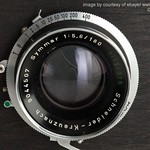
|
| Symmar in Synchro-Compur shutter image by ebayer www_leicashop_com (Image rights) |
- Angulon and Super Angulon
- Radionar and Isconar: triplet lenses
- Tele Xenar (4 element) and Tele Arton (5 element) Telephoto lenses
- Symmar: Initially a 3+3 Dagor-type sold as triple convertible, later a Plasmat sold as convertible
- Variogon: range of zoom lenses
- Xenar: mostly four element designs, copies of the Carl Zeiss Tessar, though some f/2.8 Xenars were a five element design (5 elements in four groups)
- Xenon: six element design, for high aperture lenses
Radionar lenses were assembled in the 1930s by the Japanese company Neumann & Heilemann, certainly from loose elements supplied by Schneider. See here for dating the serial numbers of Schneider lenses.
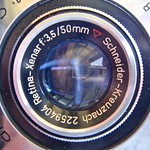
|
| Schneider Retina-Xenar image by Dirk HR Spennemann (Image rights) |
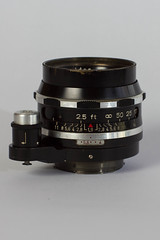
|
| Exakta variant of Xenon image by ATNewton (Image rights) |
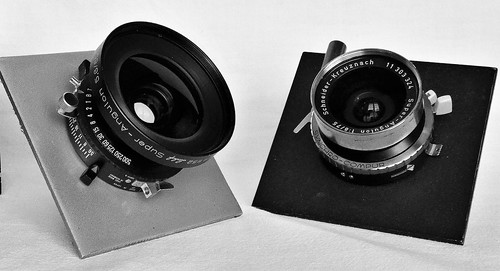
|
| Schneider Super Angulon lenses image by NATHAN (Image rights) |
See also
The links go directly to the Schneider section:
- 39mm screw lenses
- 42mm screw lenses
- Exakta lenses
- Hasselblad
- Leicaflex / Leica R lenses
- Rolleiflex SL35 lenses
Cameras with a fixed Schneider lens
- Adox 300
- Agfa Karat 12,36 and Karat IV)
- Balda Baldaxette, Baldina, Super Baldina, Jubillete, Baldalette, Baldini, Baldinette, Super Baldinette, Super Pontura, Baldessa
- Certo Dollina I, Dollina II, Dollina III, Super Dollina
- Franka Solida, Super Frankarette
- Gamma Perla
- Kodak Duo Six-20 (various models)
- Kodak Easyshare DX6490
- Kodak Instamatic 500
- Kodak Retina and Retinette (various models)
- Kodak Regent II
- Linhof Technorama 617 and 617S
- Nagel Pupille and Vollenda 3x4
- Plaubel Makina IIa
- Rollei 35 (1972-1973 only)
- Rollei Rolleicord and Rolleiflex (various models)
- Welta Welti, Weltini, and Weltur
- Zeiss Ikon Ikonta 522/24
Links
- ↑ 1.0 1.1 “Vom Weinhandel zur Optik…” at [fotointern.ch]
- ↑ DRP 240.457 at German Patent and Trademark Oficce
- ↑ Hartmut Thiele, Die Deutsche Photoindustrie - Wer war Wer, 8th edition, Munich 2021.
- ↑ DRP 439.556 at German Patent and Trademark Oficce
- ↑ Schneider homepage
- Homepage of Schneider Kreuznach, in English and in German
- Company's archive in German (archived)
- Overview Company's patents (archived)
- Schneider lens age by serial number